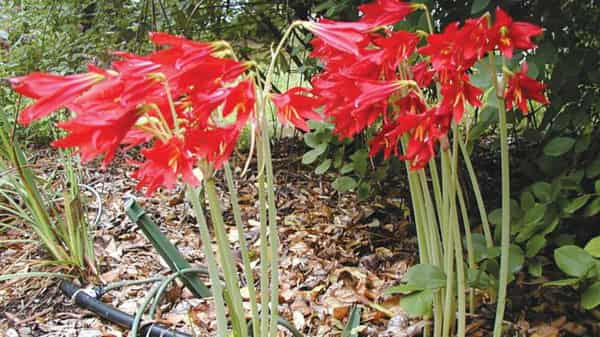
With the dry season setting in even though the rains are still trying to prolong their stay. It’s obvious the dry season has moved in. The cold chilly breezes have gone, replaced by the hot dusty winds, with the unbearable heat and high humidity setting in.
Now, comes the Christmas lily comes shooting up to take center stage, pushing the lingering hibiscus to the sidelines.
Amaryllis belladonna is a favourite of many gardeners because it is very easy to cultivate, the beautiful big flowers are an eye-catching sight anywhere with unforgettable soft fragrance. It doesn’t take any special care for it to bloom. Amaryllis belladonna is an ornamental plant which is native to the Cape Province in South African. It was discovered growing wild on the Cape of Good Hope by a few Dutch growers who emigrated to South African. This wild Amaryllis produced 2 to 3 spikes per bulb, each spike with 4 to 6 flowers. Soon it was crossed with Dutch Amaryllis Hippeastrum, which was the beginning of the new race of Amaryllis which have many of the good characteristics of the Dutch Amaryllis, as well as those of the robust, wild African one. It is now widely cultivated and naturalized in different parts of the world.
The Cape Amaryllis belladonna is native of the dry regions of Cape Province where it grows in rocky arid locations. Though native to South Africa, it is widely cultivated worldwide for its pink bell-shaped blossoms. Belladonna is latin meaning beautiful lady.
About the Amaryllis Belladonna and it’s popular names.
The scientific name of this plant is Amaryllis belladonna, is the only species in the Amaryllis genus which means the African Amaryllis (A.Belladona) is the “true “Amaryllis. It belong to the family (genera) Amaryllidaceae which forms a large group of over 6o genera. Other genera of horticultural importance found in warm climate regions include Clivia, Crinuum, Cyrthanthus, Nerine and Scadoxus. There are many common names around the world: belladonna lily; March lily; Naked lady lily;. In Nigeria the common name is Christmas lily and to some is Harmattan lily because the appearance coincides with the Harmattan season, which starts from November and last till March/April of the following, year.
The appearance of the tall, flower stalk without any leaves accounts for the name ‘Naked Lady’. This strange phenomenon of flower before foliage is known as hysteranthy. Amarylliss is a crowd-pleaser with look-at me blossoms in cheerful dramatic blooms Few bulb plants are easier to grow than the Amaryllis and few with greater exuberance and beauty.
The beauty of the Amaryllis is that anybody can make them happen. Before they are even buried in the soil they sprout plumb buds full of promise. They continue shooting up bloom spikes, despite forgetful watering, and less than perfect growing conditions. Amaryllis makes all of our thumbs green.
There are no fail bulbs. Amaryllis are a power house and mostly long-lived, perennial herb arising from a bulb or less commonly a rhizome. Amaryllis hybrid is known as Hippeastrum, with spectacular flowers. Plant breeders have developed more than 600 varieties which are widely distributed around the world especially flat lands of the tropics and subtropics. Many species are drought resistant Xerophytes that produce leaves when the rainy season begins.
The large flowers, and the ease with which they can be brought to bloom makes Amaryllis to be in popular and in high demand worldwide. The Amaryllis comes in many beautiful varieties, including various shades of red, white, pink, salmon and orange. There are also many striped and multicolored varieties usually combining shades of pink, or red or white. The stems are long and usually bear two to twelve flowers with the plethora of colors and varieties, there is always one to enhance the landscape. You can mix and match by bringing them together in a large tray or putting them in separate pots arranged on shelving units to decorate the interior landscape. Of course they can be bedded planting directly in the garden.
Naked Ladies in the Garden
This plant is called ‘Naked Ladies’ for an obvious reason- the showy fragrant funnel-shaped flowers bloom on leafless stems. This strange phenomenon of flowering before the leaves appears is known as Hysteranthy. That brings us to their unique usefulness; you know how your garden looks in the mid or late dry season. Most of the big glamour is gone, and everything is looking tired, dusty, drab and hot. That is just the conditions these South African ladies are happiest in hot, dry locations or other warm places where condition can be controlled.
They just love hot dry weather, when everything appears to be barren ……….. then …voila | here come the ladies in all their nakedness and grudging perfumery. They are truly ladies who show off like the exhibitionists they are. They come into bloom to liven the landscape’s late season show. The flower color ranges from palest pink to deep pink, white, salmon, orange, depending on your climate. Hybridization has produced more colors and combinations such as white and pink varieties.
Naked but not naughty.
Amaryllis belladonna in it’s natural habitat in South African Cape province is found in small dense group among rocks. They form thick clumps and like to be crowded to form lots of flowers. Therefore the best place to plant them will be in the rock garden. In a created landscape, their leafless stem and the fact that they are perfectly happy in partial shade as well as in full sun makes them great for planting among shade loving plants as host as , day lilies, violets, geraniums or anything that has foliage all year long. Amaryllis belladonna can be used mixed in between Agapanthus as a good combination. They can also be grown between a ground cover in mixed annual or herbaceous border. The green strappy leaves are wonderful welcome sight when growing, but unsightly when they die back. Best if they are hidden behind something where the dying leaves will not be noticeable. The tall blooms with no foliage are wonderful by themselves or just blooming up through the ground covering foliage or sticking up behind a low- growing hedge, their evergreen foliage providing skirts for the ’naked ladies’. They’ll just bloom up through the ground covering foliage and everyone will think you’re a master gardener.
Growing Amaryllis bellladona
It is very easy to cultivate and tolerant to various climatic and soil conditions. This plant prefers well- drained soil and grows in different types of soil. What it cannot stand is wet soil, it will rot. The bulbs have a dormant state. After blooming has finished for the season, foliage will develop. The leaf will gather sunlight, create food through photosynthesis and strength the bulb for the future.
The leaves will stay green for few months. Then they will yellow and die back, when the foliage is absent, the bulbs are dormant. The plant is tolerant to drought conditions and requires very little watering even dry conditions. The large bulb and fleshy roots help to withstand dry conditions. Keep the soil around plant moist during growth period and allow the soil to remain dry during the dormant period. Large clumps of bulb can be divided during dormant period. The bulbs and offset should be planted in the prepared soil with the neck just above soil level. Plant each bulb at least 8-12 inches apart to allow grow space for the plant to grow. After planting, apply an inch layer of mulch or compost to cover the soil. You can also use the soft fleshy white to pink seed to propagate the plant. The seeds should be planted when it is fresh.
When seeds are sown on the potting mix and soil kept moist, it will germinate in two weeks but seedling will take 2 to 6 years or longer to flower. They can also be grown in large pots using a very porous mix. Once established these bulbs requires little attention. They are low maintenance. The Compost provided in the growing season is enough to feed the plant and produce blooms. In cultivation, the dry hot weather pleases these plants and helps ensure that flowers are produced almost every year, but in it’s wild native habitat in south African, they emerge prolifically after fires. The fragrant flowers are excellent for cutting and long lasting, for a week or more in floral arrangements.






